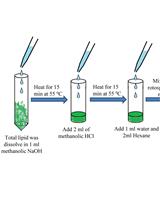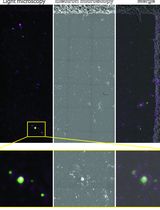- EN - English
- CN - 中文
Qualitative Analysis of Lipid Peroxidation in Plants under Multiple Stress Through Schiff’s Reagent: A Histochemical Approach
植物多重应激下脂质过氧化作用的希夫试剂定性分析:组织化学方法
发布: 2018年04月20日第8卷第8期 DOI: 10.21769/BioProtoc.2807 浏览次数: 14011
评审: Samik BhattacharyaVenkatasalam ShanmugabalajiAnonymous reviewer(s)
Abstract
Lipid peroxidation is a physiological indicator of both biotic and abiotic stress responses, hence is often used as a biomarker to assess stress-induced cell damage or death. Here we demonstrate an easy, quick and cheap staining method to assess lipid peroxidation in plant tissues. In this methodology, Schiff’s reagent, is used to assay for membrane degradation. Histochemical detection of lipid peroxidation is performed in this protocol. In brief, Schiff’s reagent detects aldehydes that originate from lipid peroxides in stressful condition. Schiff’s reagent is prepared and applied to plants tissue. After the reaction, plant tissue samples are rinsed with a sulfite solution to retain the staining color. From this analysis, qualitative visualization of lipid peroxidation in plant tissue is observed in the form of magenta coloration. This reagent is useful for visualization of stress induced lipid peroxidation in plants. In this protocol, Indica rice root, Assam tea root and Indian mustard seedlings are used for demonstration.
Keywords: Schiff’s reagent (希夫试剂)Background
Oxidative stress induced by both biotic and abiotic stress factors leads to lipid peroxidation. The peroxidation of unsaturated lipids in membrane is the most apparent symptom of oxidative stress. Lipid peroxidation is a deleterious process in plants, which affects membrane properties, causes protein degradation and limits the capacity of ionic transport, ultimately triggering the cell death process (Yamamoto et al., 2001). Malondialdehyde (MDA) content, which is a byproduct of lipid peroxidation process was found to be enhanced in rice (Ma et al., 2012; Awasthi et al., 2017), Salvinia (Mandal et al., 2013), pea (Yamamoto et al., 2001), Soyabean (Cakmak and Horst, 1991; Du et al., 2010), Indian mustard (Saha et al., 2016) on exposure to stress. The reactive oxygen species (ROS) associated with oxidative stress acts on membrane lipids to decrease membrane stability. Thus making the study of lipid peroxidation an important parameter and our protocol offers a very rapid method for the study. Schiff’s reagent reacts with aldehyde functional group of MDA to give the magenta coloration, thus acting as a key determinant of lipid peroxidation in plant tissues.
Materials and Reagents
- Glass Petri plates of 10 cm diameter (Scott Duran)
- Absorbent cotton
- Whatman 1 filter paper
- Razor blade (Glassvan, No. 23, Scalpel blade)
- 15 ml disposable centrifuge tubes (Tarsons)
- Slide
- Needle (Dispovan, sterile needle, 0.45 x 13 mm)
- Brush (Camel, Size 0)
- Gas mask
- Plant tissue (Leaf, root or whole seedling) collected freshly after stress treatment
- Distilled water
- Mercuric chloride (HgCl2) (SRL Sisco Research Laboratories, catalog number: 25699 )
- Schiff’s reagents (HiMedia Laboratories, catalog number: S074-500ML )
- Calcium nitrate tetrahydrate (Ca(NO3)2·4H2O) (HiMedia Laboratories, catalog number: GRM3903-500G )
- Potassium nitrate (KNO3) (HiMedia Laboratories, catalog number: GRM1401-500G )
- Potassium phosphate monobasic (KH2PO4) (HiMedia Laboratories, catalog number: RM3943-500G )
- Magnesium sulfate heptahydrate (MgSO4·7H2O) (HiMedia Laboratories, catalog number: RM684-5KG )
- Boric acid (H3BO3) (HiMedia Laboratories, catalog number: MB007-1KG )
- Manganese(II) chloride tetrahydrate (MnCl2·4H2O) (HiMedia Laboratories, catalog number: RM685-500G )
- Zinc sulfate heptahydrate (ZnSO4·7H2O) (HiMedia Laboratories, catalog number: PCT0118-1KG )
- Sodium molybdate dihydrate (Na2MoO4·2H2O) (HiMedia Laboratories, catalog number: GRM415-100G )
- Copper(II) sulfate pentahydrate (CuSO4·5H2O) (HiMedia Laboratories, catalog number: RM630-500G )
- Ferric chloride (FeCl3) (HiMedia Laboratories, catalog number: RM1178-1KG )
- EDTA (HiMedia Laboratories, catalog number: RM678-100G )
- Ammonium sulfate ((NH4)2SO4) (HiMedia Laboratories, catalog number: MB004-250G )
- Potassium sulfate (K2SO4) (HiMedia Laboratories, catalog number: GRM404-500G )
- Manganese sulfate monohydrate (MnSO4·H2O) (SRL Sisco Research Laboratories, catalog number: 1347151 , 500G)
- Sodium Meta-bisulphate (Na2S2O5) (Sigma-Aldrich, catalog number: 255556-100G )
- Calcium chloride dihydrate (CaCl2·2H2O) (HiMedia Laboratories, catalog number: PCT0004-500G )
- Aluminum chloride (AlCl3) (Merck, catalog number: 8010810100 )
- Cadmium chloride (CdCl2) (Thermo Fisher Scientific, catalog number: Q17584 )
- Zinc chloride (ZnCl2) (Thermo Fisher Scientific, catalog number: Q28785 )
- Ethanol (Diluent for DNA Extraction, HiMedia Laboratories, catalog number: MB228-500ML )
- Glycerol (Sigma-Aldrich, catalog number: V800196-500ML )
- Acetic acid (Thermo Fisher Scientific, catalog number: Q21057 )
- Hydrochloric acid (HCl) (HiMedia Laboratories, catalog number: AS004-2.5L )
- Schiff’s reagent staining solution (see Recipe 1)
- Hoagland solution (see Recipe 2)
- Modified nutrient solution (see Recipe 3)
- Treatment solutions (AlCl3, CdCl2, ZnCl2) (see Recipe 4)
- Sulfite solution (see Recipe 5)
- Bleaching solution (see Recipe 6)
- Storage solution (see Recipe 7)
Equipment
- Pipettes (Gilson, PIPETMAN, 2-20,20-200 and 100-1,000 µl)
- pH meter (pH Tutor, Eutech Instruments)
- Magnetic stirrer cum hot plate (Tarsons)
- Weighing balance (Sartorius, 0.1 mg-220 g)
- Water bath (Equitron unstirred water bath, Medica Instruments)
- Light microscope (Olympus, 10x objective)
- Digital camera (Nikon, model: COOLPIX P100 , 10.3 megapixel, 26x zoom)
Procedure
文章信息
版权信息
© 2018 The Authors; exclusive licensee Bio-protocol LLC.
如何引用
Awasthi, J. P., Saha, B., Chowardhara, B., Devi, S. S., Borgohain, P. and Panda, S. K. (2018). Qualitative Analysis of Lipid Peroxidation in Plants under Multiple Stress Through Schiff’s Reagent: A Histochemical Approach. Bio-protocol 8(8): e2807. DOI: 10.21769/BioProtoc.2807.
分类
植物科学 > 植物生物化学 > 脂质
生物化学 > 脂质 > 膜脂
您对这篇实验方法有问题吗?
在此处发布您的问题,我们将邀请本文作者来回答。同时,我们会将您的问题发布到Bio-protocol Exchange,以便寻求社区成员的帮助。
提问指南
+ 问题描述
写下详细的问题描述,包括所有有助于他人回答您问题的信息(例如实验过程、条件和相关图像等)。
Share
Bluesky
X
Copy link















